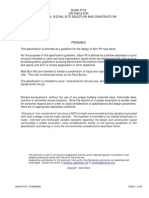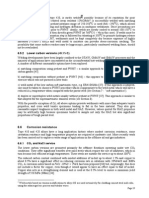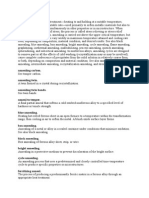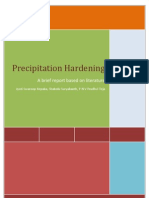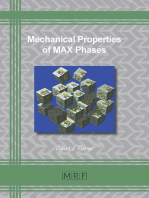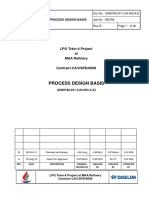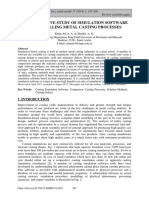Caesar II App Guide
Caesar II App Guide
Uploaded by
Venkat RanganCopyright:
Available Formats
Caesar II App Guide
Caesar II App Guide
Uploaded by
Venkat RanganCopyright
Available Formats
Share this document
Did you find this document useful?
Is this content inappropriate?
Copyright:
Available Formats
Caesar II App Guide
Caesar II App Guide
Uploaded by
Venkat RanganCopyright:
Available Formats
Designation: A 919 – 84 (Reapproved 1993)e1 An American National Standard
AMERICAN SOCIETY FOR TESTING AND MATERIALS
100 Barr Harbor Dr., West Conshohocken, PA 19428
Reprinted from the Annual Book of ASTM Standards. Copyright ASTM
Standard Terminology
Relating to Heat Treatment of Metals1
This standard is issued under the fixed designation A 919; the number immediately following the designation indicates the year of
original adoption or, in the case of revision, the year of last revision. A number in parentheses indicates the year of last reapproval. A
superscript epsilon (e) indicates an editorial change since the last revision or reapproval.
These Definitions were prepared jointly by the American Society for Metals, Society of Automotive Engineers, American Foundrymen’s
Association, and American Society for Testing and Materials.
Temperatures have been omitted purposely from these definitions, which are not intended as specifications and should not be
interpreted as such.
e1 NOTE—The designation of this standard was changed in August 1993.
Accm, Ac1, Ac3, Ac4—See transformation temperature. Definitions of the above terms are given below in their
age hardening—hardening by aging, usually after rapid cool- alphabetic positions.
ing or cold working. See aging. When applied to ferrous alloys, the term “annealing,”
aging—a change in the properties of certain metals and alloys without qualification, implies full annealing.
that occurs at ambient or moderately elevated temperatures When applied to nonferrous alloys, the term “annealing”
after hot working or a heat treatment (quench aging in implies a heat treatment designed to soften a cold-worked
ferrous alloys, natural or artificial aging in ferrous and structure by recrystallization or subsequent grain growth or to
nonferrous alloys) or after a cold-working operation (strain soften an age-hardened alloy by causing a nearly complete
aging). The change in properties is often, but not always, due precipitation of the second phase in relatively coarse form.
to a phase change (precipitation), but never involves a Any process of annealing will usually reduce stresses but if
change in chemical composition of the metals or alloys. See the treatment is applied for the sole purpose of such relief it
also age hardening, artificial aging, natural aging, over- should be designated stress relieving.
aging, precipitation hardening, precipitation heat treat- Arcm, Ar1, Ar3, Ar4—See transformation temperature.
ment, progressive aging, quench aging, and strain aging. artificial aging—aging above room temperature. See aging
annealing—heating to and holding at a suitable temperature and precipitation heat treatment. Compare with natural
and then cooling at a suitable rate, for such purposes as aging.
reducing hardness, improving machinability, facilitating cold
austempering—quenching a ferrous alloy from a temperature
working, producing a desired microstructure, or obtaining
above the transformation range in a medium having a rate of
desired mechanical, physical, or other properties. When
heat abstraction high enough to prevent the formation of
applicable, the following more specific terms should be
high-temperature transformation products, and then holding
used:
the alloy, until transformation is complete, at a temperature
black annealing below that of pearlite formation and above that of martensite
blue annealing formation.
box annealing austenitizing—forming austenite by heating a ferrous alloy
bright annealing into the transformation range (partial austenitizing) or above
flame annealing the transformation range (complete austenitizing).
full annealing baking—heating to a low temperature in order to remove
graphitizing gases.
intermediate annealing
black annealing—box annealing or pot annealing ferrous
isothermal annealing
alloy sheet, strip, or wire. See box annealing.
malleableizing
blank carburizing—simulating the carburizing operation
process annealing
without introducing carbon. This is usually accomplished by
quench annealing
using an inert material in place of the carburizing agent, or
recrystallization annealing
by applying a suitable protective coating to the ferrous alloy.
spheroidizing
blank nitriding—simulating the nitriding operation without
introducing nitrogen. This is usually accomplished by using
1
These definitions are under the jurisdiction of ASTM Committee A-1 on Steel, an inert material in place of the nitriding agent, or by
Stainless Steel, and Related Alloys and are the direct responsibility of Subcommittee applying a suitable protective coating to the ferrous alloy.
A1.92 on Terminology.
Current edition approved Oct. 26, 1984. Published December 1984. Originally blue annealing—heating hot-rolled ferrous sheet in an open
published as E 44 – 42 T. Last previous edition E 44 – 84e1. furnace to a temperature within the transformation range and
COPYRIGHT American Society for Testing and Materials
Licensed by Information Handling Services
A 919
then cooling in air, in order to soften the metal. The the outer portion of a metal object by means of diffusion at
formation of a bluish oxide on the surface is incidental. high temperature.
bluing—subjecting the scale-free surface of a ferrous alloy to close annealing—See box annealing.
the action of air, steam or other agents at a suitable cold treatment—exposing to subzero temperatures for the
temperature, thus forming a thin blue film of oxide and purpose of obtaining desired conditions or properties, such
improving the appearance and resistance to corrosion. as dimensional or structural stability. When the treatment
involves transformation of retained austenite, it is usually
NOTE 1—This term is ordinarily applied to sheet, strip, or finished parts.
It is used also to denote the heating of springs after fabrication, in order
followed by a tempering treatment.
to improve their properties. conditioning heat treatment—a preliminary heat treatment
used to prepare a material for a desired reaction to a
box annealing—annealing a metal or alloy in a sealed con- subsequent heat treatment. For the term to be meaningful,
tainer under conditions that minimize oxidation. In box the exact treatment must be specified.
annealing a ferrous alloy, the charge is usually heated slowly controlled cooling—cooling from an elevated temperature in a
to a temperature below the transformation range, but some- predetermined manner to avoid hardening, cracking, or
times above or within it, and is then cooled slowly; this internal damage or to produce a desired microstructure or
process is also called “close annealing” or “pot annealing.” mechanical properties.
See black annealing. core— (1) case hardening—interior portion of unaltered com-
bright annealing—annealing in a protective medium to pre- position, or microstructure, or both, of a case-hardened steel
vent discoloration of the bright surface. article. (2) clad products—the central portion of a multilayer
burning (burnt, burned)—a term applied to metal which has composite metallic material.
been permanently damaged by having been heated to a critical cooling rate—the minimum rate of continuous cooling
temperature close to or within the melting range. This results to prevent undesirable transformations. For steel, unless
in a structure exhibiting incipient melting or intergranular otherwise specified, it is the slowest rate at which austenite
oxidation. can be cooled from above critical temperature to prevent its
carbonitriding—a case hardening process in which a suitable transformation above the Ms temperature.
ferrous material is heated above the lower transformation critical temperature range—synonymous with transforma-
temperature in a gaseous atmosphere of such composition as tion range. The term is of historic significance only, and its
to cause simultaneous absorption of carbon and nitrogen by use is discouraged.
the surface and, by diffusion, create a concentration gradient. cyaniding—introducing carbon and nitrogen into a solid
The process is completed by cooling at a rate that produces ferrous alloy by holding above Ac1in contact with molten
the desired properties in the workpiece. cyanide of suitable composition. The cyanided alloy is
carbon potential—a measure of the ability of an environment usually quench hardened.
containing active carbon to alter or maintain, under pre- cycle annealing—an annealing process employing a predeter-
scribed conditions, the carbon content of the steel. mined and closely controlled time-temperature cycle to
produce specific properties or microstructure.
NOTE 2—In any particular environment, the carbon level attained will
depend on such factors as temperature, time, and steel composition. decarburization—the loss of carbon from the surface of a
ferrous alloy as a result of heating in a medium that reacts
carbon restoration—replacing the carbon lost in the surface with the carbon.
layer from previous processing by carburizing this layer to differential heating—heating that intentionally produces a
substantially the original carbon level. temperature gradient within an object such that, after cool-
carburizing—a process in which an austenitized ferrous ing, a desired stress distribution or variation in properties is
material is brought into contact with a carbonaceous atmo- present within the object.
sphere of sufficient carbon potential to cause absorption of diffusion coating—any process whereby a basis metal or alloy
carbon at the surface and by diffusion, create a concentration is either: (1) coated with another metal or alloy and heated to
gradient. a sufficient temperature in a suitable environment, or (2)
case—in a ferrous alloy, the outer portion that has been made exposed to a gaseous or liquid medium containing the other
harder than the inner portion (see core) as a result of altered metal or alloy, thus causing diffusion of the coating or of the
composition, or structure, or both, from treatments such as other metal or alloy into the basis metal with resultant
carburizing, nitriding, and induction hardening. change in the composition and properties of its surface.
case hardening—a generic term covering several processes direct quenching—quenching carburized parts directly from
applicable to steel that change the chemical composition of the carburizing operation.
the surface layer by absorption of carbon, nitrogen, or a double aging—employment of two different aging treatments
mixture of the two and, by diffusion, create a concentration to control the type of precipitate formed from a supersatu-
gradient. The processes commonly used are: carburizing rated alloy matrix in order to obtain the desired properties.
and quench hardening; cyaniding; nitriding; and carbo- The first aging treatment, sometimes referred to as interme-
nitriding. The use of the applicable specific process name is diate or stabilizing, is usually carried out at a higher
preferred. temperature than the second.
cementation—the introduction of one or more elements into double tempering—a treatment in which quench-hardened
2
COPYRIGHT American Society for Testing and Materials
Licensed by Information Handling Services
A 919
steel is given two complete tempering cycles at substantially specific response to hardening may be obtained.
the same temperature for the purpose of assuring completion homogenizing—holding at high temperature to eliminate or
of the tempering reaction and promoting stability of the decrease chemical segregation by diffusion.
resulting microstructure. hot-cold working—mechanical deformation of austenitic and
drawing—a misnomer for tempering. precipitation hardening alloys at a temperature just below the
ferritizing anneal—the process of producing a predominantly recrystallization range to increase the yield strength and
ferritic matrix in a ferrous alloy through an appropriate heat hardness by either plastic deformation or precipitation hard-
treatment. ening effects induced by plastic deformation, or both.
flame annealing—annealing in which the heat is applied hot quenching—an imprecise term used to cover a variety of
directly by a flame. quenching procedures in which a quenching medium is
flame hardening—a surface hardening process in which only maintained at a prescribed temperature above 160°F (71°C).
the surface layer of a suitable workpiece is heated by a induction hardening—a surface hardening process in which
suitably intense flame to above the upper transformation only the surface layer of a suitable ferrous workpiece is
temperature and immediately quenched. heated by electrical induction to above the upper transfor-
fog quenching—quenching in a mist. mation temperature and immediately quenched.
full annealing—annealing a ferrous alloy by austenitizing and induction heating—heating by electrical induction.
then cooling slowly through the transformation range. The intermediate annealing—annealing wrought metals at one or
austenitizing temperature for hypoeutectoid steel is usually more stages during manufacture and before final thermal
above Ac3and for hypereutectoid steel usually between treatment.
Ac1and Accm. interrupted aging—aging at two or more temperatures, by
gas cyaniding—a misnomer for carbonitriding. steps, and cooling to room temperature after each step. See
grain growth—an increase in the grain size of a metal, usually aging and compare with progressive aging.
as a result of heating at an elevated temperature. interrupted quenching—quenching in which the metal object
grain size—the dimensions of the grains or crystals in a being quenched is removed from the quenching medium
polycrystalline metal exclusive of twinned regions and while the object is at a temperature substantially higher than
subgrains when present. Grain size is usually estimated or that of the quenching medium. See also time quenching.
measured on the cross section of an aggregate of grains. isothermal annealing—austenitizing a ferrous alloy and then
Common units are: (1) average diameter, (2) average area, cooling to and holding at a temperature at which austenite
(3) number of grains per linear unit, (4) number of grains per transforms to a relatively soft ferrite-carbide aggregate.
unit area, and (5) number of grains per unit volume. See isothermal transformation—a change in phase at any con-
Methods E 112, for Determining The Average Grain Size.2 stant temperature.
(1)—ASTM grain size number—a grain size designation malleableizing—a process in which the ascast malleable-type
bearing a relationship to average intercept distance at 100 (white) iron is thermally treated for the purpose of convert-
diameters magnification according to the equation: G 5 ing most or all of the carbon in Fe3C to graphite (temper
ASTM Grain Size Number 5 10.00 − 2 log2 L̄, where L̄ is carbon) to produce a family of products with improved
the average intercept distance in millimetres at 100 diam- ductility.
eters magnification. maraging—a precipitation hardening treatment applied to a
(2)—average grain diameter—the mean diameter of an equi- special group of iron-base alloys to precipitate one or more
axed grain section whose size is representative of all the intermetallic compounds in a matrix of essentially carbon-
grain sections in the aggregate being measured. free martensite.
graphitizing—annealing a ferrous alloy in such a way that
NOTE 3—The first developed series of maraging steels contained, in
some or all of the carbon is precipitated as graphite. addition to iron, more than 10 % nickel and one or more supplemental
hardenability—in a ferrous alloy, the property that determines hardening elements. In this series, the aging is done at approximately
the depth and distribution of hardness induced by quenching. 900°F (482°C).
hardening—increasing the hardness by suitable treatment,
usually involving heating and cooling. When applicable, the martempering—quenching an austenitized ferrous alloy in a
following more specific terms should be used: age harden- medium at a temperature in the upper part of the martensite
ing, case hardening, flame hardening, induction harden- range, or slightly above that range, and holding in the
ing, precipitation hardening, and quench hardening. medium until the temperature throughout the alloy is sub-
heat treatment—heating and cooling a solid metal or alloy in stantially uniform. The alloy is then allowed to cool in air
such a way as to obtain desired conditions or properties. through the martensite range.
Heating for the sole purpose of hot working is excluded from martensite range—the temperature interval between Ms and
the meaning of this definition. Mf.
homogeneous carburizing—a process that converts a low- Mf—See transformation temperature.
carbon ferrous alloy to one of substantially uniform and Ms—See transformation temperature.
higher carbon content throughout the section, so that a natural aging—spontaneous aging of a super-saturated solid
solution at room temperature. See aging and compare with
artificial aging.
2
Annual Book of ASTM Standards, Vol 03.01. nitriding—introducing nitrogen into a solid ferrous alloy by
3
COPYRIGHT American Society for Testing and Materials
Licensed by Information Handling Services
A 919
holding at a suitable temperature (below Ac1 for ferritic izing and then cooling rapidly enough so that some or all of
steels) in contact with a nitrogenous material, usually am- the austenite transforms to martensite. The austenitizing
monia or molten cyanide of appropriate composition. temperature for hypoeutectoid steels is usually above Ac3
Quenching is not required to produce a hard case. and for hypereutectoid steels usually between Ac1 and Accm.
normalizing—heating a ferrous alloy to a suitable temperature quenching—rapid cooling. When applicable, the following
above the transformation range and then cooling in air to a more specific terms should be used: direct quenching, fog
temperature substantially below the transformation range. quenching, hot quenching, interrupted quenching, selec-
overaging—aging under conditions of time and temperature tive quenching, spray quenching, and time quenching.
greater than those required to obtain maximum change in a recrystallization—the formation of a new grain structure
certain property, so that the property is altered in the through nucleation and growth commonly produced by
direction of the initial value. See aging. subjecting a metal, which may be strained, to suitable
overheating—(1)in ferrous alloys, heating to an excessively conditions of time and temperature.
high temperature such that the properties/structure undergo recrystallization annealing—annealing cold-worked metal to
modification. The resulting structure is very coarse-grained. produce a new grain structure without phase change.
Unlike burning, it may be possible to restore the original recrystallization temperature—the approximate minimum
properties/structure by further heat treatment or mechanical temperature at which recrystallization of a cold worked
working, or a combination thereof. metal occurs within a specified time.
(2)—in aluminum alloys, overheating produces structures that secondary hardening—the hardening phenomenon that oc-
show areas of resolidified eutectic or other evidence that curs during high-temperature tempering of certain steels
indicates the metal has been heated within the melting range. containing one or more carbide-forming alloying elements.
patenting—in wire making, a heat treatment applied to Up to an optimum combination of tempering time and
medium-carbon or high-carbon steel before the drawing of temperature, the reaction results either in the retention of
wire or between drafts. This process consists in heating to a hardness or an actual increase in hardness.
temperature above the transformation range and then cooling selective heating—intentionally heating only certain portions
to a temperature below Ae1 in air or in a bath of molten lead of an object.
or salt. selective quenching—quenching only certain portions of an
postheating—heating weldments immediately after welding, object.
for tempering, for stress relieving, or for providing a shell hardening—a surface hardening process in which a
controlled rate of cooling to prevent formation of a hard or suitable steel workpiece, when heated through and quench
brittle structure. hardened, develops a martensitic layer or shell that closely
pot annealing—See box annealing. follows the contour of the piece and surrounds a core of
precipitation hardening—hardening caused by the precipita- essentially pearlitic transformation product. This result is
tion of a constituent from a supersaturated solid solution. See accomplished by a proper balance between section size, steel
also age hardening and aging. hardenability, and severity of quench.
precipitation heat treatment—artificial aging in which a slack quenching—the incomplete hardening of steel due to
constituent precipitates from a supersaturated solid solution. quenching from the austenitizing temperature at a rate
See artificial aging, interrupted aging, and progressive slower than the critical cooling rate for the particular steel,
aging. resulting in the formation of one or more transformation
preheating—heating before some further thermal or mechani- products in addition to martensite.
cal treatment. For tool steel, heating to an intermediate snap temper—a precautionary interim stress-relieving treat-
temperature immediately before final austenitizing. For ment applied to high-hardenability steels immediately after
some nonferrous alloys, heating to a high temperature for a quenching to prevent cracking because of delay in tempering
long time in order to homogenize the structure before them at the prescribed higher temperature.
working. soaking—prolonged holding at a selected temperature.
process annealing—in the sheet and wire industries, heating a solution heat treatment—heating an alloy to a suitable
ferrous alloy to a temperature close to, but below, the lower temperature, holding at that temperature long enough to
limit of the transformation range and then cooling, in order cause one or more constituents to enter into solid solution
to soften the alloy for further cold working. and then cooling rapidly enough to hold these constituents in
progressive aging—aging by increasing the temperature in solution.
steps or continuously during the aging cycle. See aging and spheroidizing—heating and cooling to produce a spheroidal or
compare with interrupted aging. globular form of carbide in steel. Spheroidizing methods
pseudocarburizing—See blank carburizing. frequently used are:
pseudonitriding—See blank nitriding. (1)—Prolonged holding at a temperature just below Ae1.
quench aging—aging induced by rapid cooling after solution (2)—Heating and cooling alternately between temperatures
heat treatment. that are just above and just below Ae1.
quench annealing—annealing an austenitic ferrous alloy by (3)—Heating to a temperature above Ae1 or Ae3 and then
solution heat treatment. cooling very slowly in the furnace or holding at a tempera-
quench hardening—hardening a ferrous alloy by austenit- ture just below Ae1.
4
COPYRIGHT American Society for Testing and Materials
Licensed by Information Handling Services
A 919
(4)—Cooling at a suitable rate from the minimum temperature by cold work or heat treatment, or both.
at which all carbide is dissolved, to prevent the re-formation time quenching—interrupted quenching in which the duration
of a carbide network, and then reheating in accordance with of holding in the quenching medium is controlled.
method (1) or (2) above. (Applicable to hypereutectoid steel transformation ranges or transformation temperature
containing a carbide network.) ranges—those ranges of temperature within which austenite
spinodal decomposition—mechanism of a phase separation forms during heating and transforms during cooling. The
from a solid solution into two homogeneous phases of two ranges are distinct, sometimes overlapping but never
different chemical composition, each having the same crystal coinciding. The limiting temperatures of the ranges depend
structure as the parent metal. on the composition of the alloy and on the rate of change of
spray quenching—quenching in a spray of liquid. temperature, particularly during cooling. See transforma-
stabilizing treatment—any treatment intended to stabilize the tion temperature.
structure of an alloy or the dimensions of a part.(1) heating transformation temperature—the temperature at which a
austenitic stainless steels that contain titanium, columbium, change in phase occurs. The term is sometimes used to
or tantalum to a suitable temperature below that of a full denote the limiting temperature of a transformation range.
anneal in order to inactivate the maximum amount of carbon The following symbols are used for iron and steels:
by precipitation as a carbide of titanium, columbium, or Accm—in hypereutectoid steel, the temperature at which the
tantalum.(2) transforming retained austenite in parts made solution of cementite in austenite is completed during
from tool steel. (3) precipitating a constituent from a heating.
non-ferrous solid solution to improve the workability, to Ac1—the temperature at which austenite begins to form during
decrease the tendency of certain alloys to age harden at room heating.
temperature, or to obtain dimensional stability. Ac3—the temperature at which transformation of ferrite to
strain aging—aging induced by cold working. See aging. austenite is completed during heating.
stress relieving—heating to a suitable temperature, holding Ac4—the temperature at which austenite transforms to delta
long enough to reduce residual stresses and then cooling ferrite during heating.
slowly enough to minimize the development of new residual
Ae1, Ae3, Aecm, Ae4—the temperatures of phase changes at
stresses.
equilibrium.
surface hardening—a generic term covering several processes
Arcm—in hypereutectoid steel, the temperature at which pre-
applicable to a suitable ferrous alloy that produces by quench
cipitation of cementite starts during cooling.
hardening only, a surface layer that is harder or more wear
resistant than the core. There is no significant alteration of Ar1—the temperature at which transformation of austenite to
the chemical composition of the surface layer. The processes ferrite or to ferrite plus cementite is completed during
commonly used are induction hardening, flame hardening, cooling.
and shell hardening. Use of the applicable specific process Ar3—the temperature at which austenite begins to transform to
name is preferred. ferrite during cooling.
temper brittleness—brittleness that results when certain steels Ar4—the temperature at which delta ferrite transforms to
are held within, or are cooled slowly through, a certain range austenite during cooling.
of temperature below the transformation range. The brittle- Ms—the temperature at which transformation of austenite to
ness is revealed by notched-bar impact tests at or below martensite starts during cooling.
room temperature. Mf—the temperature, during cooling, at which transformation
tempering—(1) reheating a quench hardened or normalized of austenite to martensite is substantially completed.
ferrous alloy to a temperature below the transformation NOTE 4—All these changes except the formation of martensite occur at
range (Ac1), and then cooling at any desired rate. (2) a term lower temperatures during cooling than during heating, and depend on the
used in conjunction with a qualifying adjective to designate rate of change of temperature.
the relative properties of a particular metal or alloy induced
This standard is subject to revision at any time by the responsible technical committee and must be reviewed every five years and
if not revised, either reapproved or withdrawn. Your comments are invited either for revision of this standard or for additional standards
and should be addressed to ASTM Headquarters. Your comments will receive careful consideration at a meeting of the responsible
technical committee, which you may attend. If you feel that your comments have not received a fair hearing you should make your
views known to the ASTM Committee on Standards, 100 Barr Harbor Drive, West Conshohocken, PA 19428.
COPYRIGHT American Society for Testing and Materials
Licensed by Information Handling Services
You might also like
- Tube-to-Tubesheet Joints - BaherDocument51 pagesTube-to-Tubesheet Joints - BaherNAMO100% (4)
- Burn Pit CriteriaDocument28 pagesBurn Pit CriteriaVenkat Rangan100% (7)
- A941-13b Standard Terminology Relating To Steel, Stainless Steel, Related Alloys, and FerroalloysDocument8 pagesA941-13b Standard Terminology Relating To Steel, Stainless Steel, Related Alloys, and FerroalloysChuthaNo ratings yet
- 11-14%Cr IIW Document - Part 2Document21 pages11-14%Cr IIW Document - Part 2GagrigoreNo ratings yet
- A908-03 (2013) Standard Specification For Stainless Steel Needle TubingDocument8 pagesA908-03 (2013) Standard Specification For Stainless Steel Needle TubingChuthaNo ratings yet
- Steel, Stainless Steel, Related Alloys, and Ferroalloys: Standard Terminology Relating ToDocument8 pagesSteel, Stainless Steel, Related Alloys, and Ferroalloys: Standard Terminology Relating ToChristopherJohnGoodingNo ratings yet
- Steel, Stainless Steel, Related Alloys, and Ferroalloys: Standard Terminology Relating ToDocument8 pagesSteel, Stainless Steel, Related Alloys, and Ferroalloys: Standard Terminology Relating TolinamariamonroyginetNo ratings yet
- Steel, Stainless Steel, Alloys, and Ferroalloysl: To RelatedDocument8 pagesSteel, Stainless Steel, Alloys, and Ferroalloysl: To RelatedarunrathikaNo ratings yet
- Types of AnnealingDocument2 pagesTypes of AnnealingAshwani Kansara50% (2)
- Iron Castings: Standard Terminology Relating ToDocument4 pagesIron Castings: Standard Terminology Relating ToPushkar GopalNo ratings yet
- 2 HeatTreatment-1Document43 pages2 HeatTreatment-1PrakashNo ratings yet
- Heat Treatment TypesDocument1 pageHeat Treatment TypesАхмед НашатNo ratings yet
- EMAT 2K23 (9th)Document52 pagesEMAT 2K23 (9th)haristariq2004No ratings yet
- Heat TreatmentDocument20 pagesHeat Treatmentshanu100% (1)
- Select Subjetcts of MetallurgyDocument3 pagesSelect Subjetcts of MetallurgyRenato BarretoNo ratings yet
- Material Technology: Diploma Mechanical Engineering Semester: 3Document26 pagesMaterial Technology: Diploma Mechanical Engineering Semester: 3Deepakraj SolankiNo ratings yet
- MME09MM 1101different Heat Treatment ProcessDocument2 pagesMME09MM 1101different Heat Treatment Processjohn powerNo ratings yet
- DUDLEYs HANDBOOK OF PRACTICAL GEAR DESIG Part265Document1 pageDUDLEYs HANDBOOK OF PRACTICAL GEAR DESIG Part265mzengineer.orgNo ratings yet
- Heat Treatment First Mid Term by SR Pradhan SirDocument111 pagesHeat Treatment First Mid Term by SR Pradhan Sirgaurav dixitNo ratings yet
- Annealing of Aluminum and Its Alloys: Ju Rgen Hirsch, Hydro Aluminium Rolled Products GMBH-R&DDocument11 pagesAnnealing of Aluminum and Its Alloys: Ju Rgen Hirsch, Hydro Aluminium Rolled Products GMBH-R&DAmin AminiNo ratings yet
- Amt 611 Heat TreatmentDocument44 pagesAmt 611 Heat TreatmentJhalbert Belmonte100% (1)
- Mccu 216 Manual t13Document12 pagesMccu 216 Manual t13carlos daniel Ortiz suarezNo ratings yet
- DUDLEYs HANDBOOK OF PRACTICAL GEAR DESIG Part266Document1 pageDUDLEYs HANDBOOK OF PRACTICAL GEAR DESIG Part266mzengineer.orgNo ratings yet
- Astm A644Document5 pagesAstm A644Luis Fernando RuedaNo ratings yet
- MD ReviewerDocument9 pagesMD ReviewerMelord Rada RoneNo ratings yet
- Thermal TreatmentDocument10 pagesThermal TreatmentАліна ПетровськаNo ratings yet
- Astm A 941 - A941m - 2018Document8 pagesAstm A 941 - A941m - 2018Vigneshwaran RNo ratings yet
- The 4 Types of Heat Treatment Steel Undergoes - Kloeckner MetalsDocument5 pagesThe 4 Types of Heat Treatment Steel Undergoes - Kloeckner MetalsSrivishnu vemulaNo ratings yet
- Steel and AluminumDocument123 pagesSteel and AluminumClein BaltazarNo ratings yet
- Unit 2: Heat Treatment ProcessesDocument53 pagesUnit 2: Heat Treatment ProcessesAmit KumarNo ratings yet
- Heattreatment English 99Document13 pagesHeattreatment English 99shreemugNo ratings yet
- Precipitation Hardening Stainless Steels - Alloys, Properties, Fabrication Processes, Supplier Data by AalcoDocument6 pagesPrecipitation Hardening Stainless Steels - Alloys, Properties, Fabrication Processes, Supplier Data by AalcoKalpanaBansalNo ratings yet
- ASM Subject Guide - HeatTreating PDFDocument7 pagesASM Subject Guide - HeatTreating PDFJhon Alexander VilladaNo ratings yet
- Heat Treatment QuizDocument6 pagesHeat Treatment QuizAdhiNo ratings yet
- Precipitation Hardening Stainless SteelsDocument2 pagesPrecipitation Hardening Stainless SteelsRongbaaz BongNo ratings yet
- VegetaDocument2 pagesVegetafranz justin kyle syNo ratings yet
- Farm Machinery and Equipment I 3 (2+1)Document3 pagesFarm Machinery and Equipment I 3 (2+1)Vinoth KumarNo ratings yet
- Heat TreatmentDocument32 pagesHeat TreatmentMradul ChaudharyNo ratings yet
- A Case Study of Heat Treatment On Mechanical Properties and Microstructure of C1040 SteelDocument5 pagesA Case Study of Heat Treatment On Mechanical Properties and Microstructure of C1040 SteelShafayat HossainNo ratings yet
- ASTM-A941 Rev. 0Document8 pagesASTM-A941 Rev. 0Hittanshu SutharNo ratings yet
- 211 2BDocument35 pages211 2BMada ChohNo ratings yet
- Material Science & Metallurgy 2131904: Heat Treatment ProcessesDocument47 pagesMaterial Science & Metallurgy 2131904: Heat Treatment ProcessesNyanda MadiliNo ratings yet
- Heat Treatment GlossaryDocument7 pagesHeat Treatment GlossaryhsemargNo ratings yet
- FM&E - Lesson 3. Heat Treatment of Farm EquipmentDocument3 pagesFM&E - Lesson 3. Heat Treatment of Farm EquipmentParmod SharmaNo ratings yet
- Stucor Me3392-RjDocument21 pagesStucor Me3392-Rjjabivi3253No ratings yet
- Iron Carbon Diagram Form The Basis of Heat TreatmentsDocument41 pagesIron Carbon Diagram Form The Basis of Heat TreatmentsMuhammad TalhaNo ratings yet
- Annealing 430Document7 pagesAnnealing 430steffen.oerlikonNo ratings yet
- Heat Treatment Non FerrousDocument4 pagesHeat Treatment Non FerrousJhalbert BelmonteNo ratings yet
- AluminiumDocument31 pagesAluminiumsamuelNo ratings yet
- Precipitation HardeningDocument6 pagesPrecipitation Hardeningjyoti swaroop repaka100% (9)
- Tempil - Basic Guide To Ferrous MetallurgyDocument3 pagesTempil - Basic Guide To Ferrous MetallurgyDananNo ratings yet
- Heat Treatment of Metals PDFDocument12 pagesHeat Treatment of Metals PDFAzize RazamNo ratings yet
- Friction Stir Welding of Aluminium AlloysDocument108 pagesFriction Stir Welding of Aluminium AlloyssarikaNo ratings yet
- Course: Materials TechnologyDocument60 pagesCourse: Materials TechnologyelvisNo ratings yet
- Heat Treatment 7Document12 pagesHeat Treatment 7watersoul.nNo ratings yet
- Heat Treatments For Improving The Weldability and Formability of Udimet 700Document9 pagesHeat Treatments For Improving The Weldability and Formability of Udimet 700Enary SalernoNo ratings yet
- Heat TreatmentDocument1 pageHeat Treatmentjohn powerNo ratings yet
- Design of Forming Processes Bulk Forming PDFDocument23 pagesDesign of Forming Processes Bulk Forming PDFAsia Ct0% (1)
- Heat Treatment-1 PDFDocument104 pagesHeat Treatment-1 PDFSagnik ChakrabortyNo ratings yet
- The Working of Steel: Annealing, Heat Treating and Hardening of Carbon and Alloy SteelFrom EverandThe Working of Steel: Annealing, Heat Treating and Hardening of Carbon and Alloy SteelNo ratings yet
- Selenium cells: The construction, care and use of selenium cells with special reference to the Fritts cellFrom EverandSelenium cells: The construction, care and use of selenium cells with special reference to the Fritts cellNo ratings yet
- SP 2390 StressDocument60 pagesSP 2390 StressVenkat Rangan100% (1)
- SP 1125Document12 pagesSP 1125Venkat Rangan100% (1)
- Passive Fire Proofing Layout For Proposed EquipmentsDocument1 pagePassive Fire Proofing Layout For Proposed EquipmentsVenkat RanganNo ratings yet
- CS-19335-12-PIP-4014 - Rev 06Document1 pageCS-19335-12-PIP-4014 - Rev 06Venkat RanganNo ratings yet
- CS-19335-12-PIP-4010 - Rev 08Document1 pageCS-19335-12-PIP-4010 - Rev 08Venkat RanganNo ratings yet
- Apps On Google PlayDocument5 pagesApps On Google PlayVenkat RanganNo ratings yet
- 1671 8560 71 C160 0165 Commented 25.10.22Document1 page1671 8560 71 C160 0165 Commented 25.10.22Venkat RanganNo ratings yet
- Process Design Basis: LPG Train-4 Project at MAA RefineryDocument42 pagesProcess Design Basis: LPG Train-4 Project at MAA RefineryVenkat Rangan100% (1)
- PAPER 8 The Miskar Gas Field RevDocument27 pagesPAPER 8 The Miskar Gas Field RevVenkat RanganNo ratings yet
- PMS (1CC1P01)Document263 pagesPMS (1CC1P01)Venkat RanganNo ratings yet
- Preface: Discourses Book 2, ChapterDocument2 pagesPreface: Discourses Book 2, ChapterVenkat RanganNo ratings yet
- Pipe Hangers and SupportsDocument179 pagesPipe Hangers and SupportsVenkat RanganNo ratings yet
- Metric PVC Piping SystemDocument20 pagesMetric PVC Piping SystemVenkat RanganNo ratings yet
- Constant Spring HangerDocument25 pagesConstant Spring HangerVenkat Rangan100% (1)
- Project Standards and Specifications Flare and Blowdown Systems Rev01Document12 pagesProject Standards and Specifications Flare and Blowdown Systems Rev01Venkat Rangan100% (1)
- Sample Business Associate Acknowledgment LetterDocument1 pageSample Business Associate Acknowledgment LetterVenkat RanganNo ratings yet
- ISO 13709/ API 610 (VS6) Vertical Multistage Double Case Process PumpDocument8 pagesISO 13709/ API 610 (VS6) Vertical Multistage Double Case Process PumpVenkat RanganNo ratings yet
- Method 22 - Visual Determination of Fugitive Emissions From Material Sources and Smoke Emissions From FlaresDocument11 pagesMethod 22 - Visual Determination of Fugitive Emissions From Material Sources and Smoke Emissions From FlaresVenkat RanganNo ratings yet
- Open Pit Burning: General Facts and InformationDocument2 pagesOpen Pit Burning: General Facts and InformationVenkat RanganNo ratings yet
- HD Api610Document5 pagesHD Api610Venkat RanganNo ratings yet
- Introduction To Strain GaugesDocument32 pagesIntroduction To Strain GaugesManjunatha Babu N.s100% (2)
- Ams 5663Document12 pagesAms 5663SENTHILVEL IAINo ratings yet
- Text17 2 - 197 209 PDFDocument13 pagesText17 2 - 197 209 PDFridhombsNo ratings yet
- FET MRIU Dec 2015 PDFDocument581 pagesFET MRIU Dec 2015 PDFNishu Dalal0% (1)
- Steel MakingDocument38 pagesSteel Makings.samNo ratings yet
- AISI 6150 Alloy Steel (UNS G61500)Document3 pagesAISI 6150 Alloy Steel (UNS G61500)Bharti ShahiNo ratings yet
- Treatment Process For Making Material Softer But Does Not Produce The Uniform Material Properties of AnnealingDocument3 pagesTreatment Process For Making Material Softer But Does Not Produce The Uniform Material Properties of AnnealingSyahirzabidi100% (1)
- Metu-Mete-Phd Theses Since 1971 PDFDocument5 pagesMetu-Mete-Phd Theses Since 1971 PDFsiaeatoomNo ratings yet
- Carbon Transfer in Sodium System Under Thermal CyclingDocument4 pagesCarbon Transfer in Sodium System Under Thermal CyclingVijay GuptaNo ratings yet
- Use of Alloying To Effect An Equiaxed Microstructure in Additive Manufacturing and Subsequent Heat Treatment of High-Strength Titanium AlloysDocument14 pagesUse of Alloying To Effect An Equiaxed Microstructure in Additive Manufacturing and Subsequent Heat Treatment of High-Strength Titanium AlloysIpsita MohantyNo ratings yet
- 2007 Russian Aluminum Alloys For Ultra Deep Water EngDocument8 pages2007 Russian Aluminum Alloys For Ultra Deep Water EngDiegoNo ratings yet
- Etchant Test On CastingsDocument2 pagesEtchant Test On CastingsHarshaVeeragandhamNo ratings yet
- Development of SN-ZN Coating Steel Sheet For Automotive Fuel Tanks, ECOKOTE-SDocument6 pagesDevelopment of SN-ZN Coating Steel Sheet For Automotive Fuel Tanks, ECOKOTE-Skirana01No ratings yet
- Biomaterials For Hip Implants - Important Considerations Relating To The Choice of MaterialsDocument14 pagesBiomaterials For Hip Implants - Important Considerations Relating To The Choice of MaterialsLokesh RathiNo ratings yet
- 1.1.c-Technology and Society in The Bronze AgesDocument13 pages1.1.c-Technology and Society in The Bronze Agestwinkledreampoppies50% (2)
- Refining Karat Gold and Silver Jewelry Using InQuarting MethodDocument7 pagesRefining Karat Gold and Silver Jewelry Using InQuarting MethodAFLAC ............100% (1)
- 1.1 ARL Ispark BrochureDocument12 pages1.1 ARL Ispark BrochureTUXEDO TVNo ratings yet
- Speeds & Feeds DrillsDocument9 pagesSpeeds & Feeds DrillsHolleyMooreNo ratings yet
- Understanding The Environmental Limits in NACE MR0175-2003Document30 pagesUnderstanding The Environmental Limits in NACE MR0175-2003sain65100% (1)
- Materials of Art and ArchaeologyDocument23 pagesMaterials of Art and ArchaeologysimpleidNo ratings yet
- F1684 06 Reapproved 2011 - Standard Specification For Iron-Nickel and Iron-Nickel-Cobalt Alloys For Low Thermal Expansion ApplicationsDocument8 pagesF1684 06 Reapproved 2011 - Standard Specification For Iron-Nickel and Iron-Nickel-Cobalt Alloys For Low Thermal Expansion ApplicationsAyodejiNo ratings yet
- Laser Cladding PowdersDocument6 pagesLaser Cladding PowdersSAPA FirstNo ratings yet
- Titanium AlloysDocument19 pagesTitanium AlloysMila DevitaNo ratings yet
- Social Science (Geography-Chapter 4-Industries) Gist - Class VIIIDocument9 pagesSocial Science (Geography-Chapter 4-Industries) Gist - Class VIIIrghosh2434No ratings yet
- G8 WS CHM Warda MetalsDocument6 pagesG8 WS CHM Warda Metalsrose roseyNo ratings yet
- Atlas Aluminium Datasheet 6063 Rev Oct 2013 PDFDocument2 pagesAtlas Aluminium Datasheet 6063 Rev Oct 2013 PDFAdamMitchellNo ratings yet
- Liquid Penetrant System Chemistry and Effluent Waste: HapterDocument0 pagesLiquid Penetrant System Chemistry and Effluent Waste: HapterSihem BenNo ratings yet
- Tank Field Inspection and Test ProcedureDocument29 pagesTank Field Inspection and Test Proceduresbmmla91% (22)

